
This site uses cookies, by continuing to use this site you accept the terms of our privacy policy
Feed 2.0 Loading...
David Stewart MSP Visits Gills Harbour
10th August 2015
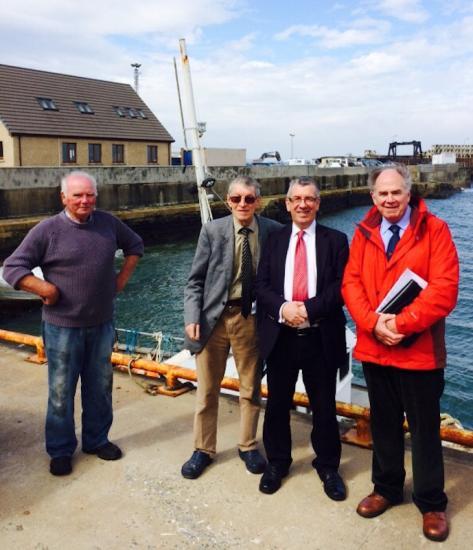
Scotland's Shadow Minister for Transport Mr David Stewart, Labour MSP for the Highlands & Islands constituency, has made a fact-finding visit to community-owned Gills Harbour on the shores of the Pentland Firth's Inner Sound.
There he was shown around by three officers of Gills Harbour Ltd (GHL), the Canisbay company that owns and operates the Scottish Mainland's most Northerly port.
The Shadow Minister promised 'to do anything that I can' to assist 'the people's port' that belongs to 600 electors in Canisbay, with its upgrading plans aimed at ensuring that it plays an integral role in key aspects of Pentland Firth tidal-stream electricity generation in the future.
Separately he met with Mr Andrew Banks, OBE, whose Pentland Ferries Ltd company leases some land from GHL, where the private firm has developed at a multi-million pound cost as an essential component of its busy 'short sea route' to Orkney.
Its RO.RO 2,800 tonne modern 70-metre long catamaran vessel Pentalina has been sailing to capacity in recent weeks, despite providing four return passages on four days of the week during the peak summer months. The service receives no taxpayers' subsidy and is Scotland's most successful 'Mainland to island group' link.
The local unpaid representatives showed Mr Stewart pictures taken during this year (2015) of numbers of smaller many-purpose 15-25 metre long craft, several known as multi-cats, actively using Gills Harbour as tidal stream 'horizontal hydro-electricity' operations in the Inner Sound scale up. And they let the Shadow Minister see several 'letters of support' for its Inner Basin upgrade plans from the owners/operators of such vessels.
Atlantis Resources plc's subsidiary MeyGen Ltd is in the process of creating a four-turbine 'demonstration array' in the Inner Sound within one mile of the entrance channel to Gills Harbour. Together with the necessary on-shore facilities, this will cost of over £50 million. It is a 'World leader' on this scale, with first electricity generated and delivered onshore by late nest year.(2016).
Cable-laying operations from the sub-sea site of the turbines 35 metres under the Inner Sound's sea-surface to the Caithness coast at Ness of Quoys, near Canisbay's ancient Kirk on the shores of Gills Bay, are scheduled to start within six weeks.(early September, 2015).
The Inner Sound is the first of four Crown Estate seabed leases for the purpose of generating 'tidal stream' electricity in the Pentland Firth. All four lie in the narrowest eastern end of the strait, with none more that eight miles out from Gills Harbour.
'The operators of multi-cats and other workboats have made Gills the port of choice for the vessels', said GHL chairman Bill Mowat, a former four-term Councillor for NE Caithness.
'They have learned that using Gills provided them with fuel efficiency, given the short distances when compared to other Mainland ports.
He added: 'We stressed to Mr Stewart that using Gills means better human productivity for the engineers and crews on board, while it also adds to safety as there are no potentially-hazardous 'breaking white-water on every tidal cycle' roosts (i.e. tide-races) to be crossed'.
The North Coast harbour team told the Shadow Minister that, if Scotland & Britain were serious about obtaining larger quantities of cost-effective electricity for the future from the Pentland Firth, then its port on Gills Bay was an indispensable part of this.
Experts predict that 'horizontal hydro' electricity from a fully-developed the Pentland Firth will generate as much power as four modern nuclear power-stations, if the delivery price of this electricity is right.
PHOTO
GHL emeritus director Billy Magee; chairman Bill Mowat; David Stewart MSP and Rev. Lyall Rennie, Hon. Sec. & director of GHL.
Related Businesses
Related Articles
21/10/2022
Three Cats At Gills Harbour
Two catamaran work-boats berthed at Gills Harbour this week with the trans-Pentlnd ferry MV Alfred, also a catamaran, in the background. The larger workboat is MPC Athenia which was being used as a floating base or ROVs - remote underwater vessels, for detailed inspections on the three turbines operating at the MeyGen demonstration subsea site one and a half miles off Gills Harbour.
12/6/2022
GILLS HARBOUR Ltd ANNUAL GENERAL MEETING
GILLS HARBOUR Ltd - ANNUAL GENERAL MEETING at JOHN O'GROATS VILLAGE HALL, MONDAY JUNE 13th @ 7.30 PM. GILLS HARBOUR IS THE ONLY OFFICIALLY-RECOGNISED 'ECONOMIC DEVELOPMENT AREA' IN NE CAITHNESS.22/3/2021
Latest Boats At Gills Harbour For Work At Meygen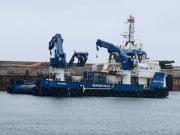
£10 million 'Isle of Jura' temporarily based at Gills Harbour in Far North of Scotland for her crew's debut tasks in the tidal-stream electricity field at the MeyGen sub-sea site, one mile off the little Caithness's port entrance channel. One of the UK's most modern marine renewables service vessels made her debut calls at community-owned Gills Harbour, near John O'Groats, over the 2021 Spring Equinoctial weekend.
23/2/2021
Busy Gills Harbour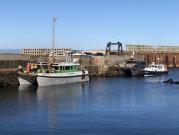
Its been a busy few days at local community-owned Gills Harbour ..... sometimes in suberb sunny weather as here ...
26/11/2020
Energy Developments Continue at Gills Harbour and the Pentland Firth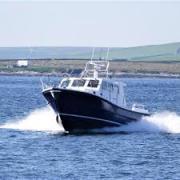
The company behind the world-leading tidal-stream prototype power plant in the Pentland Firth's Inner Sound is set to start manufacturing a new-style turbine that is hopes will reduce the project's generating costs. Simec Atlantis Energy (SAE) and a privately-owned specialist engineering firm from Spain's Bay of Biscay coastline have jointly been conducting 'research and development' (R& D) on the project for almost a year and are now ready to give it the go-ahead.
8/10/2020
New Generation of office-bearers set to step up at Gills Harbour Ltd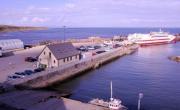
A new generation of younger local folk look set to take over the reins of running Gills Harbour Ltd, the local company that owns and operates the busy little port on the shores of the Pentland Firth's Inner Sound that holds its AGM this Saturday (10.10.20) morning at 10:00 am. The influx of younger blood comes after two key directors of the group that had run 'Canisbay's Peoples Port' both announced their retirement from office, whilst another Gills Harbour Ltd (GHL) office-bearer has declined to seek re-election.
19/8/2020
MV Alfred And MV Pentalina Together At Gills
An 'old friend' returns to Gills Bay after an absence of manymonths. The 2,400 tonne 70 m.
16/8/2020
Normand Cutter, The Norwegian-owned Offshore Construction Vessel at Gills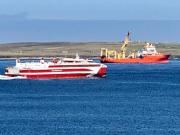
Here is the Normand Cutter, the Norwegian-owned offshore construction vessel that has been the base for works on Simec Atlantis Energy's (SAE's) MeyGen site in the Pentland Firth's Inner Sound, off Gills Bay during the current neap-tide sequence, that has lasted most of the week commencing 11.08.20. Picture by retired C of S Kirk Minister the Rev Lyall Rennie, who lives at Lower Warse, Canisbay, on the shores of Gills Bay..
9/10/2019
New Ferry For Pentland Ferries Arrives Safely
Scotland's most modern + environmentally-friendly, fuel-efficient ROPAX ferry ship rge MV Alfred, arrived AM today (Wed 09.10.19 at St Margarets Hope. The boat went round to Kirkwall immediately at the end of 9,000+ miles voyage from the Strategic Marine yard near Ho Chi Minh city (ex.
20/3/2019



